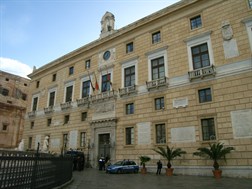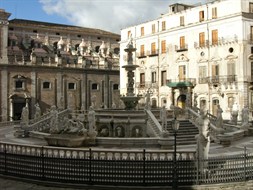Our Lady of the Chain, Our Lady of Portosalvo, Palazzo delle Aquile and the Fontana Pretoria
 The first stop gives importance to a church which is symbolically relevant to Palermo, Our Lady of the Chain (Figure 1). The church derives its name from a chain which extends from it and which is anchored to the other end of the cove at night to block the entrance to unknown ships. Shots are fired with blanks «anco a rimpetto della chiesa di Nostra Signora di Portosalvo» (also in front of the church of Our Lady of Portosalvo), a fifteenth-century church dedicated to the Virgin patroness of sailors. Today the church has a very special structure, as during the construction of the CassaroThe road is the result of decades of hard work. It began on the opposite side of the city, where there are the Royal Palace and the Cathedral, in 1567. The work continued in stages, with a certain slowness, because it was to demolish most of the buildings that are located on the street towards the port. All was concluded only in the early eighties of the sixteenth century., at the end of the sixteenth century, during the demolition work, its apse was unscrupulously eliminated.
The first stop gives importance to a church which is symbolically relevant to Palermo, Our Lady of the Chain (Figure 1). The church derives its name from a chain which extends from it and which is anchored to the other end of the cove at night to block the entrance to unknown ships. Shots are fired with blanks «anco a rimpetto della chiesa di Nostra Signora di Portosalvo» (also in front of the church of Our Lady of Portosalvo), a fifteenth-century church dedicated to the Virgin patroness of sailors. Today the church has a very special structure, as during the construction of the CassaroThe road is the result of decades of hard work. It began on the opposite side of the city, where there are the Royal Palace and the Cathedral, in 1567. The work continued in stages, with a certain slowness, because it was to demolish most of the buildings that are located on the street towards the port. All was concluded only in the early eighties of the sixteenth century., at the end of the sixteenth century, during the demolition work, its apse was unscrupulously eliminated.
 Continuing, a “grandissima quantità di mascoli” are also fired at the Municipal Palace or Palazzo delle Aquile (Figure 2), a building of the late fifteenth century that we see today in nineteenth century guise. The Fontana Pretoria (Figure 3) that stands in front of the building shows the splendor of the capital of the kingdom of Sicily to the recently arrived Viceroy. It is a masterpiece elaborated in Palermo, after the acquisition by the Senate of a large number of statues by Luigi di Toledo, Cosimo de’ MediciCosimo I de’ Medici (1519-1574), was the first Duke of Florence and Grand Duke of Tuscany from 1537 to 1574. He married Leonor Álvarez de Toledo y Pimentel, by whom he had a total of 11 children. During the reign of Cosimo I the Medici increased the great art collection that can be admired today in the Uffizi Gallery. Cosimo and his wife also ordered the construction of the Boboli gardens, which became the paradigm of the Italian garden.‘s brother in law. Carved mostly by the Tuscan Francesco CamillianiFrancesco Camilliani, or Della Camilla (1530-1576) was a Florentine sculptor and architecht. His most famous work is undoubtedly the Fontana Pretoria, built in Florence and then brought, twenty years later, to Palermo., they were assembled by his son Camillo CamillianiSon of Francesco, Camillo Camilliani was born in Florence, but he is famous for his works in Sicily. He worked on the Fontana Pretoria of Palermo, the most important work of his father, and then he devoted himself to military engineering and to the construction of a series of fortresses on Sicilian coasts. He died in Palermo in 1603., active in Sicily in the second half of the sixteenth century. Unlike contemporary works, the Fontana Pretoria was not based on a well-defined iconographic design, curiously, the “program” was conceived of ten years after the laying of the last fragment of marble.
Continuing, a “grandissima quantità di mascoli” are also fired at the Municipal Palace or Palazzo delle Aquile (Figure 2), a building of the late fifteenth century that we see today in nineteenth century guise. The Fontana Pretoria (Figure 3) that stands in front of the building shows the splendor of the capital of the kingdom of Sicily to the recently arrived Viceroy. It is a masterpiece elaborated in Palermo, after the acquisition by the Senate of a large number of statues by Luigi di Toledo, Cosimo de’ MediciCosimo I de’ Medici (1519-1574), was the first Duke of Florence and Grand Duke of Tuscany from 1537 to 1574. He married Leonor Álvarez de Toledo y Pimentel, by whom he had a total of 11 children. During the reign of Cosimo I the Medici increased the great art collection that can be admired today in the Uffizi Gallery. Cosimo and his wife also ordered the construction of the Boboli gardens, which became the paradigm of the Italian garden.‘s brother in law. Carved mostly by the Tuscan Francesco CamillianiFrancesco Camilliani, or Della Camilla (1530-1576) was a Florentine sculptor and architecht. His most famous work is undoubtedly the Fontana Pretoria, built in Florence and then brought, twenty years later, to Palermo., they were assembled by his son Camillo CamillianiSon of Francesco, Camillo Camilliani was born in Florence, but he is famous for his works in Sicily. He worked on the Fontana Pretoria of Palermo, the most important work of his father, and then he devoted himself to military engineering and to the construction of a series of fortresses on Sicilian coasts. He died in Palermo in 1603., active in Sicily in the second half of the sixteenth century. Unlike contemporary works, the Fontana Pretoria was not based on a well-defined iconographic design, curiously, the “program” was conceived of ten years after the laying of the last fragment of marble.
 The fountain was built during the viceroyalty of Marco Antonio Colonna. According to recent studies, the signature of his wife Felice Orsini lies hidden among its marbles. The noble woman, in fact, added an eloquent bear – orso – to the statues, as if to leave traces of her presence in Palermo. This hypothesis is particularly fascinating. In fact, if history has long since demonstrated the possibility of female intervention in the public sphere, where the profiles of female sovereigns have been considered, their cultural contributions and their political importance, and beyond the question of their reproductive capacity, have been valued. This was not the case for the wives of viceroys: they were noblewomen who do not have a public role and are therefore intended to live in the shadows from which they emerge with extreme difficulty. Even today, in this parade proceeds to the cathedral, the viceroy’s wife is present, but in a carriage. The artillery fire is not for her, while the viceroy proceeds.
The fountain was built during the viceroyalty of Marco Antonio Colonna. According to recent studies, the signature of his wife Felice Orsini lies hidden among its marbles. The noble woman, in fact, added an eloquent bear – orso – to the statues, as if to leave traces of her presence in Palermo. This hypothesis is particularly fascinating. In fact, if history has long since demonstrated the possibility of female intervention in the public sphere, where the profiles of female sovereigns have been considered, their cultural contributions and their political importance, and beyond the question of their reproductive capacity, have been valued. This was not the case for the wives of viceroys: they were noblewomen who do not have a public role and are therefore intended to live in the shadows from which they emerge with extreme difficulty. Even today, in this parade proceeds to the cathedral, the viceroy’s wife is present, but in a carriage. The artillery fire is not for her, while the viceroy proceeds.
